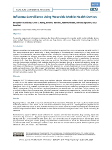The potential of mHealth devices to register illness has been recognized. This study is the first to present population-level influenza signals in a large network of mHealth users. Mobile health device data linked to ILI-specific survey responses taken during the 2017/18 flu season demonstrate clear aggregate patterns across several dimensions including sleep, steps, and heart rate.
These signals suggest the potential for systems to rapidly process individual-level responses to classify ILI and to use such classifiers for ILI surveillance. The data described here, high resolution individual-level behavioral and physiological data linked to timely survey responses, suggests the potential to further enhance outbreak detection and improve characterization of ILI patterns. The setting of our study, a very large network of mobile health device users who have consented to the prospective use of their data and to being queried about their health status, could provide a framework for automated prospective influenza surveillance using “real world evidence”.
Employed over a population-representative sample, this approach could provide adjunct to standard clinically-based sentinel systems.






